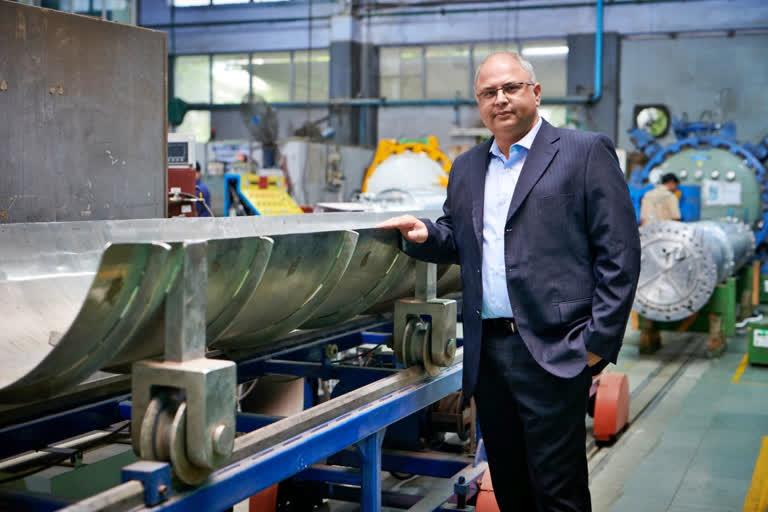New Delhi: Development of the Kaveri engine by the Gas Turbine Research Establishment (GTRE) and DRDO led to the creation of the required eco-system and technical know-how for indigenous design, development and manufacturing of fighter jet engines in the country, a top executive of Godrej Aerospace told ETV Bharat.
The lack of indigenous capability to design and manufacture fighter jet engines in the country is considered as the biggest challenge in India’s quest for achieving self-reliance in the defence and aerospace sectors as the country is still using fighter jet engines imported from the USA for its Light Combat Aircraft Tejas.
In an exclusive interview to ETV Bharat, Maneck Eddie Behramkamdin, AVP and Business Head, Godrej Aerospace, discussed the Godrej Group’s participation in India’s defence and space programmes, including the company’s role in the manufacturing of Vikas engines that power ISRO’s PSLV and GSLV rockets and Kaveri jet engine developed by the GTRE-DRDO.
Maneck says Godrej Aerospace’s latest and the most prestigious foray is the Kaveri engine that the company has won as all 8 modules of the Kaveri engine on order from Gas Turbine Research Establishment and Defence Research and Development Organization (GTRE-DRDO) will be built by Godrej.
“It is a development order for six engines and as we move forward, we hope to make many more such engines in future,” Maneck said. The design is with the GTRE-DRDO and the manufacturing partner for all the tooling, methoding and processing, and selecting the local suppliers, is all in Godrej's work scope.
Also Read: India buying Russian oil is none of our business, says German ambassador
The top Godrej executive said that in order to develop and produce the Kaveri engine, the company will not bring in any foreign partner. "We are going to do all the engineering parts for its production. Everything is going to be Indian," said Maneck. The GTRE engine developed by the GTRE-DRDO has already passed the test.
Speaking about the Kaveri engine’s development, Maneck said the engine was a dry engine and it was without any afterburner. It is going to be used on one of the other platforms and not the fighter platforms. It is going to be used in an autonomous unmanned vehicle, he said.
“It is a 46 kiloton Newton engine, It is not a 110-kiloton newton engine. It has already passed the test, It is proven now. We hope to make it and deliver the engine on time so now the actual manufactured engine can also be tested,” said the Godrej executive.
India’s state-owned aircraft manufacturer HAL is using US defence and aerospace giant General Electric’s GE-F404 engine to power India’s homegrown Light Combat Aircraft Tejas.
Speaking about the company’s future plans in the defence and aerospace sector, such as its participation in the manufacturing of fighter jets in the country, Maneck said Godrej hopes to become a partner whenever a GE engine or Rolls-Royce engine gets selected by the government.
"If not as a full-fledged integrator then we definitely hope to become a supply chain partner with a sizable amount of components coming from the house of Godrej," he said.
“We have now the experience with the Kavery engine so most of the processes and infrastructure that is required to build an engine is with Godrej Group. This is what we hope to leverage. The engine is the most complex part of engineering, this knowledge will be available with Godrej when a foreign partner comes to India,” noted the Godrej executive.
In response to a question about what is the biggest challenge for India as a nation in developing a fully functional fighter jet engine for even a basic aircraft like Tejas, Maneck said this is not just one challenge, there are thousands of challenges.
He said the country needs to develop the whole supply chain, it needs to develop various types of technologies so that will come with time.
“Materials, the alloys which will be required will be imported, we need our mills to produce special alloys and materials for aircraft engines. The technical part which is going into welding, coating, and heat surfacing, we needed to develop these technologies, which will be developed with this particular order. The knowledge that will be developed will get us to the next phase,” Maneck said. “We have developed some technologies, as I said this engine (GTRE-DRDO's Kaveri engine) has been developed, so the ecosystem is there.”
Godrej Aerospace is now also working on actuators and Line Replaceable Units (LRUs) for the Light Combat Aircraft (LCA) Tejas programme. The company supplies them to Hindustan Aeronautics Limited Lucknow.
“We are also getting into some new technology development, the company is now working on the development of airframes for an unmanned autonomous vehicle (UAV) using composite materials,” said the Godrej executive.
Brahmos Programme
Talking about private defence companies’ participation in India’s supersonic cruise missile Brahmos, which has been jointly developed by Russia and India, Maneck says nearly 70-75 per cent manufacturing of the Brahmos missile has been done in the country.
He said while the airframe, wings, fins and nose caps of Brahmos missiles are manufactured by Godrej, some parts are manufactured by Larsen & Toubro, for electronics, there is a whole ecosystem that comes from the Indian defence industry,
“I would say 70 to 75% have been indigenised. It is coming from the defence industry and is being packaged at Hyderabad or Nagpur, wherever they (Brahmos Aerospace) are doing it,” said the Godrej executive. “There are industry partners that are making all the parts for Brahmos except for the engine which is still not here. I think this is something the government is working on. The engine is still imported from Russia.”



